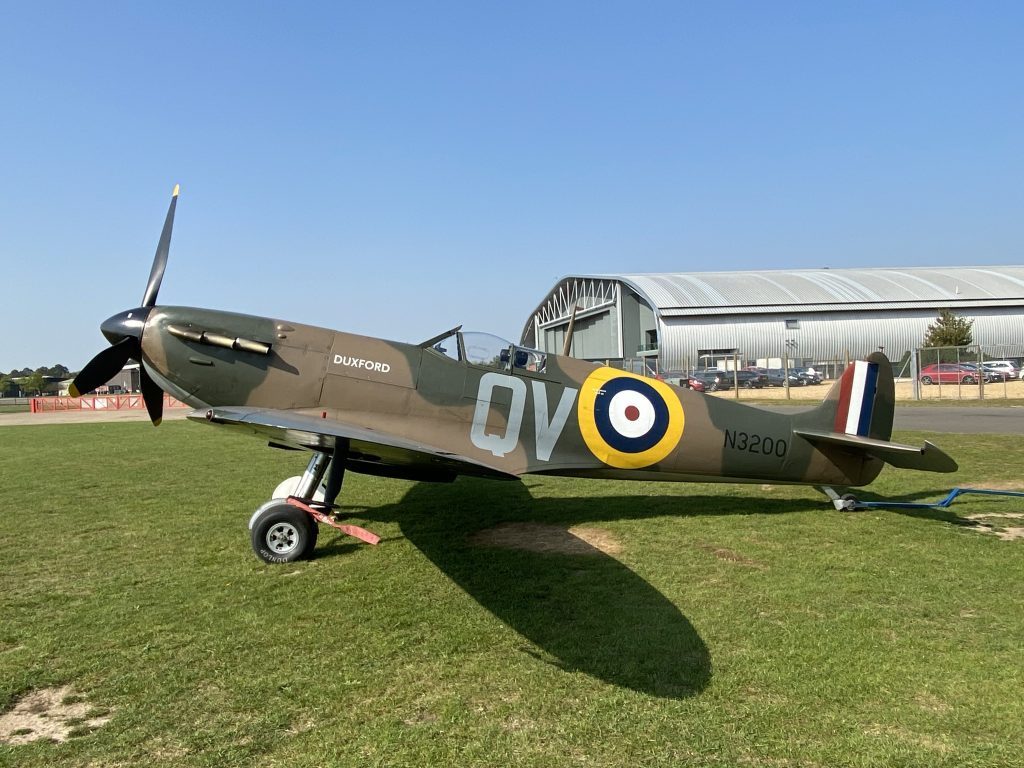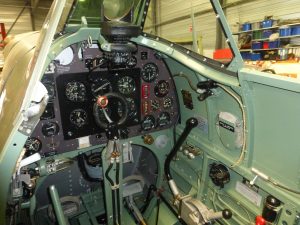Third in a series about aircraft in the HAA’s National Treasurers list

Amongst the Historic Aircraft Association Top Ten list of our list of ‘National Treasures’ is Spitfire Mk.1 N3200. This is a survivor from the Battle of France and thus is a very early mark Spitfire from before the Battle of Britain.
N3200 served with 19 Squadron at Duxford during the Battle of France. On 26th of May 1940 it was flown by 19 Squadron’s Commanding Officer, Squadron Leader Geoffrey Stephenson on a sortie to protect British forces during the evacuation of Dunkirk. He shot down a Junkers Ju87 Stuka and then N3200 was hit, sustaining damage in its single radiator which cools the Rolls Royce Merlin engine. A liquid-cooled engine like the Merlin cannot continue with such damage and Stephenson had to put the Spitfire down on the beach at Sangatte and was captured.
N3200 was recovered in 1986 after years of being buried in the sands at Sangatte. It was acquired in 2000 by Dr.Philip Kaplan and Simon Marsh. Historic Flying Limited – appropriately at its former base at Duxford – were commissioned to restore N3200 to its original specification. The Aircraft Restoration Company and Retro Track and Air also participated in its restoration.
Following its successful restoration N3200 returned to the air in 2014. In 2015 it was generously donated to the nation by Dr.Kaplan and his family.
What is notable about N3200 is that it is a Spitfire that flies in an early specification before the major modifications followed in time for the Battle of Britain thus it is a time capsule of how early Spitfires handled.
The Spitfire Mk.1 entered service with the RAF in 1938 and 19 Squadron at Duxford were the first to receive the new fighter which had first flown in March 1936.
The Mk.1 has a number of very notable features starting with the undercarriage. N3200 has the early hand pump undercarriage, This was later changed on Spitfires to have an engine driven pump for the operation of the undercarriage.

It is powered by an early Rolls Royce Merlin III which gave just over 1000hp
It also has a flat sided canopy which was later changed to be bulged at the sides and the top to improve visibility – vital in a fighter.
There are some changed to the cockpit on later model Spitfires and there is a comparison photo showing N3200 and a Mk.V Spitfire (BM597 of the Historic Aircraft Collection). In N3200 you can clearly see the handpump for the undercarriage, In addition N3200 has two fuel tank gauges for the top and bottom tanks. (This was reduced to one in later models so that you get fuel indications only when you are down to the contents of the bottom fuel tank).

The MK.1 also had landing lights which were supposed to assist with night operations. However the Spitfire was found to be completely unsuitable for night operations and these lights were removed in later aircraft.
The first Spitfires had two blade fixed pitch propellors. This is a design compromise and means that you are flying in what is basically like a car in 4th gear. Taking off and climb is sluggish and you do not get the best out of the engine.
As soon as was possible in service Spitfires were modified with de Havilland three blade variable-pitch propellers. These propellers had two positions – Fine and Coarse. Fine would be for take off and landing – this to compare with a car would be like 1st or 2nd gear for better pulling away – better take off performance in an aeroplane. In flight the blade pitch would be changed to Coarse. This would be like changing gear in a car from 1st to 4th and is still a compromise in performance. In combat the pilot would have to closely monitor the engine so not exceed engine limitations and damage it. N3200 has this variable pitch (Fine-Coarse) de Havilland propeller.
Just to add that if you the propeller wrongly selected Coarse for take off on the ground the aircraft would run out of runway and an example of this is Douglas Bader crashing through the fence at Duxford.
Spitfires were equipped with Constant-Speed propellers (Constant Speed Unit or CSU) in time for the key combats in the Battle of Britain. A Constant-Speed Propeller enables the pilot to select the rpm required and concentrate on handling the combat without over-boosting and damaging the engine. This reduced pilot workload, critical in combat.
Spitfire Mk.1 N3200 is a true time capsule of an early handling Spitfire and thus on HAA’s ‘National Treasures’ list.
Howard Cook
2021
Spitfire Mk.Ia N3200 sitting in the waves on the beach at Sangatte after being shot down on May 26th, 1940. (photo via Global Aviation Resource)
